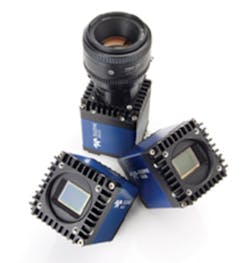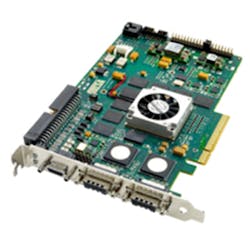Machine Vision Focuses on Standards and Integration
Emerging vision standards are promising increased speeds and flexibility for machine-vision systems while customers are looking for intelligent combinations of vision components such as cameras, image sensors, frame grabbers, illumination components, lenses, and software. These trends are evident from presentations and exhibits at the AIA’s The Vision Show held last spring and from plans for Messe Stuttgart’s upcoming VISION 2012 set for Nov. 6-8 in Stuttgart (see sidebar).
The specific new and proposed standards highlighted at The Vision Show—Camera Link High Speed (CLHS) and USB3 Vision—complement existing standards including Camera Link, CoaXPress, FireWire, and GigE Vision. And you can expect updates on many of these standards—particularly USB3 Vision—at VISION 2012.
The Vision Show marked the formal release of version 1.0 of the CLHS standard. Bob McCurrach, the AIA’s director of standards development, announced at the show that the standard now is available for free download from the AIA website. Mike Miethig, Teledyne DALSA R&D manager and chair of AIA CLHS committee, described how the standard will serve demanding machine-vision and inspection applications.
Complementing the standard are CLHS intellectual property (IP) cores developed by the Camera Link HS Committee. The cores support two protocol implementations: M and X where the M protocol handles 3.125-Gb/s links while the X protocol provides 10-Gb/s links. 10-Gb/s links can be achieved using 10-Gb/s-capable FPGA serdes or XAUI-capable FPGA serdes (4 x 3.125 Gb/s) and an XAUI-to-SFI conversion chip. The AIA said the cores enable short time to market, reduce development risk, guarantee interoperability, and decrease support costs. They let users focus on device features rather than protocol development.
The new standard, said Miethig, speaking at The Vision Show, provides plenty of bandwidth to support real-time, frame-by-frame camera control for reliable, error-free operation. In addition to offering greater bandwidth than earlier Camera Link specifications, the new standard allows longer distances. Miethig noted that users are not restricted to single sources for interconnect hardware. Camera Link relies on off-the-shelf transmission technology, including CX4 Infiniband electrical connectors and SFP/SFP+ fiber-optic components.
As for specifics, Miethig said the new standard supports data rates and camera-to-frame-grabber distances ranging from 300 MB/s at 10 meters over copper to 1,200 MB/s at 10,000 meters over fiber. The standard offers 3.2-ns jitter to support real-time triggering; latency is on the order of 100 to 300 ns.
Miethig noted the reliability offered by the standard, “We put a lot of emphasis on this—I can’t stress that enough.” The reliability stems from features such as two-of-three voting techniques and CRC-32 redundancy checks with resend capability for video frames. Fiber-optic implementations, he said, will offer inherent immunity to EMI.
The new IP core, Miethig said, will be FPGA-ready, initially supporting devices from Altera and Xilinx. The core, which implements the CLHS message layer, will be available in RTL VHDL format.
Hosted by AIA, CLHS is a G3 standard with the support of the Japanese and European machine-vision organizations (JIIA and EMVA, respectively) as well as AIA. Through the AIA, a 15-member CLHS committee of independent companies develops, deploys, and updates the standard.
Courtesy Teledyne DALSA
On display at the show were several specific products that support CLHS, including Teledyne DALSA’s Falcon2 Camera and Xcelera PX8 Frame Grabber. The Falcon2 Series (Figure 1) is Teledyne DALSA’s latest area-scan camera family, featuring CMOS technology for high-speed, high-resolution imaging with true global-shutter operation. The Falcon2, available in 4- and 8-Mpixel versions operating at 168 and 90 f/s, respectively, delivers high-quality images of fast-moving objects without smear or distortion.
Courtesy of Teledyne DALSA
The Xcelera-HS PX8 Frame Grabber (Figure 2) has been built within DALSA’s Trigger-to-Image Reliability technology framework. The technology leverages DALSA’s hardware and software to control, monitor, and correct the image-acquisition process from the time that an external trigger event occurs to the moment the data is sent to the host, providing traceability when errors do occur and permitting recovery from those errors.
USB3 Vision
Eric Gross, senior software engineer at National Instruments and the AIA USB3 Vision committee chair, outlined progress on the USB3 Vision standard at the show. He began with a description of USB 3.0: It supports up to 400 MB/s bandwidth, operates over 5-meter passive-cable distances, delivers 5 V at 4.5 W to a device, and will be supported by nearly all operating systems. Compared with USB 2.0, he said, USB 3.0 is 10 times faster, can deliver twice the power to a device, and uses one-third the power for data transfer.
As for USB in general, Gross said, nearly 1 billion units ship per year, and it is estimated that 100 million USB 3.0 controllers have shipped to date, with Intel and AMD offering native USB 3.0 support in their latest chipsets. He added that Windows 8 will offer out-of-the-box USB 3.0 support.
USB3 Vision, Gross said, will add machine-vision-specific support similar to what is available now with Camera Link, IIDC FireWire, and GigE Vision. He noted that even though USB 2.0 has been adopted for machine-vision applications, the lack of a machine-vision-specific version of the USB 2.0 standard meant that vision applications provided least-common-denominator support or depended on camera-specific SDKs. USB 3.0, he said, will overcome that limitation and be based on existing standards like GenICam to provide support for various camera interfaces.
Machine-vision-specific features, Gross said, include variable-sized image/data frames, zero-copy transfers, and reliable recovery of error conditions.
The standard, Gross said, is hosted by AIA, and like CLHS, is a G3 standard with the support of EMVA and JIIA as well. Companies involved in the USB 3.0 Vision effort, he said, include 10 camera vendors, six software-library vendors (including National Instruments), and three cable vendors. He said that the Draft 1.0 standard document is ready for internal feedback and testing; development now is on track for availability of the final 1.0 standard at Vision 2012 in Stuttgart in November.
Room for Multiple Standards
Certainly, the new CLHS and emerging USB 3.0 Vision standards will not replace existing standards. John Egri, director of engineering at IMPERX, made the case at The Vision Show for CoaXPress, describing it as a high-speed, point-to-point serial communications standard for the transmission of video over standard 75-Ω coaxial cable. The standard specifies a downlink (camera-to-host) standard of up to 6.25 Gb/s for video transport and a 20-Mb/s uplink (host-to-camera) for communications and control. In addition, it can deliver 24 V at 500 mA of power.
The standard’s protocol defines the transfer of video and control data as well as triggering and general-purpose I/O over a single link, with cable lengths extending to 100 meters and beyond. Egri elaborated on the standard in a white paper.1
IMPERX offers a variety of CoaXPress-compliant cameras with resolutions ranging from VGA to 29 Mpixels, including the ICX-B6620 6,600- x 4,400-pixel, 2.5-f/s model with a 35-mm Kodak KAI-29050 interline transfer CCD image sensor.
Multi-Standard Vendor Efforts
And vendors continue to develop products offering various interfaces. In April, for example, Point Grey announced the addition of new 6.0-Mpixel models to its Grasshopper Express line of IEEE 1394b (FireWire-b) digital cameras series. Building on Point Grey’s experience with Sony EXview HAD CCD II technology, the Grasshopper Express GX-FW-60S6 uses the Sony ICX694 to deliver high resolution and sensitivity in a compact, low-cost package.
At The Vision Show, Matrox Imaging also announced its 4Sight GP fifth-generation family of industrial computers for machine-vision and medical applications. Powered by an embedded third-generation Intel Core processor, the new 4Sight GP is designed to offer desktop performance in a small, rugged enclosure.
To enable support for multiple standards, the 4Sight GP accommodates full-height, half-length PCIe boards, enabling developers to insert standard add-in cards such as Matrox frame grabbers that support analog, Camera Link, and CoaXPress interfaces as well as DVI and SDI video capture. Matrox says the 4Sight GP integrates Gigabit Ethernet and USB 3.0 interfaces, which provide native support for GigE Vision cameras as well as forthcoming USB 3.0 Vision cameras.
The G3 associations and the many participating machine-vision vendors will continue developing and updating standards. The challenge will be in acquiring the knowledge that enables you to choose the optimum one for your application.
Reference
1. Egri, J., CoaXPress—High speed camera interface, IMPERX, White Paper, Rev. 2.0, April 18, 2012.
For More Information
AIA
IMPERX
Kodak
Matrox Imaging
National Instruments
Point Grey
Sony
Teledyne DALSA
Messe Stuttgart Celebrates 25 Years of VISION
Participants convening at VISION 2012 Nov. 6-8 in Stuttgart will mark the 25th anniversary of the annual event. Show organizers expect about 360 exhibitors at the show. They report that, according to the current registration data, participants hail from roughly 30 countries. The largest international exhibitor contingent is from the United States, followed by Great Britain, Switzerland, Canada, Japan, and the Netherlands. Other exhibitors will represent countries including China, Israel, the Russian Federation, South Korea, and Taiwan.
“Some of today’s key players have been there from the start—that’s what we have in common. And many new exhibitors have come onboard in recent years,” stated Thomas Walter, industrial solutions area manager of Messe Stuttgart.
Attendees will view vision components such as cameras, image sensors, frame grabbers, illumination components, lasers, lenses, and software. Show organizers report that visitors are increasingly interested in the “intelligent combination” of these components—that is, in complete machine-vision systems and application solutions.
A highlight of this year’s event will be the Integration Area, in which only system providers and integrators can showcase their applications. “It is the starting point for the end user,” stated Walter. “Here the end user can find a solution and develop contacts with system integrators.”
In addition to addressing their traditional industrial customers, exhibitors will be focusing on visitors representing medical, electronics, and automotive companies. The medical market looks particularly attractive, said show exhibitors, who estimate its value at $100 to $200 billion depending on the definition. In pursuit of this market, some exhibitors will participate in what show organizers call the Medical Discovery Tour, at which exhibitors will showcase their machine-vision products and services for medical applications.
Finally, a special event on international machine vision standards, organized by AIA, EMVA, and JIIA, will address the benefits and practical use of high-speed interfaces such as CoaXPress and Cameral Link HS.


